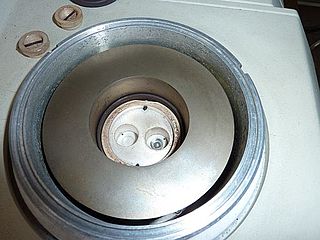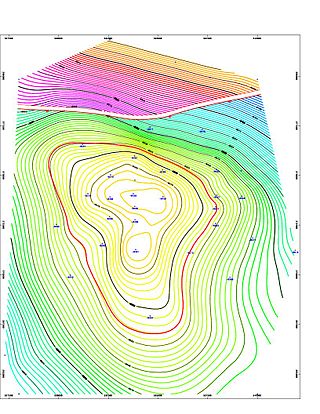Related Research Articles

Statistics is the discipline that concerns the collection, organization, analysis, interpretation, and presentation of data. In applying statistics to a scientific, industrial, or social problem, it is conventional to begin with a statistical population or a statistical model to be studied. Populations can be diverse groups of people or objects such as "all people living in a country" or "every atom composing a crystal". Statistics deals with every aspect of data, including the planning of data collection in terms of the design of surveys and experiments.

Differential scanning calorimetry (DSC) is a thermoanalytical technique in which the difference in the amount of heat required to increase the temperature of a sample and reference is measured as a function of temperature. Both the sample and reference are maintained at nearly the same temperature throughout the experiment. Generally, the temperature program for a DSC analysis is designed such that the sample holder temperature increases linearly as a function of time. The reference sample should have a well-defined heat capacity over the range of temperatures to be scanned. Additionally, the reference sample must be stable, of high purity, and must not experience much change across the temperature scan. Typically, reference standards have been metals such as indium, tin, bismuth, and lead, but other standards such as polyethylene and fatty acids have been proposed to study polymers and organic compounds, respectively.
Statistical bias is a systematic tendency which causes differences between results and facts. The bias exists in numbers of the process of data analysis, including the source of the data, the estimator chosen, and the ways the data was analyzed. Bias may have a serious impact on results, for example, to investigate people's buying habits. If the sample size is not large enough, the results may not be representative of the buying habits of all the people. That is, there may be discrepancies between the survey results and reality. Therefore, understanding the source of statistical bias can help to assess whether the observed results are close to actuality.
Chemometrics is the science of extracting information from chemical systems by data-driven means. Chemometrics is inherently interdisciplinary, using methods frequently employed in core data-analytic disciplines such as multivariate statistics, applied mathematics, and computer science, in order to address problems in chemistry, biochemistry, medicine, biology and chemical engineering. In this way, it mirrors other interdisciplinary fields, such as psychometrics and econometrics.
Selection bias is the bias introduced by the selection of individuals, groups, or data for analysis in such a way that proper randomization is not achieved, thereby failing to ensure that the sample obtained is representative of the population intended to be analyzed. It is sometimes referred to as the selection effect. The phrase "selection bias" most often refers to the distortion of a statistical analysis, resulting from the method of collecting samples. If the selection bias is not taken into account, then some conclusions of the study may be false.

Flow cytometry (FC) is a technique used to detect and measure physical and chemical characteristics of a population of cells or particles.
Well logging, also known as borehole logging is the practice of making a detailed record of the geologic formations penetrated by a borehole. The log may be based either on visual inspection of samples brought to the surface or on physical measurements made by instruments lowered into the hole. Some types of geophysical well logs can be done during any phase of a well's history: drilling, completing, producing, or abandoning. Well logging is performed in boreholes drilled for the oil and gas, groundwater, mineral and geothermal exploration, as well as part of environmental and geotechnical studies.

A petroleum reservoir or oil and gas reservoir is a subsurface accumulation of hydrocarbons contained in porous or fractured rock formations.
In fluid statics, capillary pressure is the pressure between two immiscible fluids in a thin tube, resulting from the interactions of forces between the fluids and solid walls of the tube. Capillary pressure can serve as both an opposing or driving force for fluid transport and is a significant property for research and industrial purposes. It is also observed in natural phenomena.
Enhanced oil recovery, also called tertiary recovery, is the extraction of crude oil from an oil field that cannot be extracted otherwise. EOR can extract 30% to 60% or more of a reservoir's oil, compared to 20% to 40% using primary and secondary recovery. According to the US Department of Energy, carbon dioxide and water are injected along with one of three EOR techniques: thermal injection, gas injection, and chemical injection. More advanced, speculative EOR techniques are sometimes called quaternary recovery.
Petrophysics is the study of physical and chemical rock properties and their interactions with fluids.
A surrogate model is an engineering method used when an outcome of interest cannot be easily measured or computed, so an approximate mathematical model of the outcome is used instead. Most engineering design problems require experiments and/or simulations to evaluate design objective and constraint functions as a function of design variables. For example, in order to find the optimal airfoil shape for an aircraft wing, an engineer simulates the airflow around the wing for different shape variables. For many real-world problems, however, a single simulation can take many minutes, hours, or even days to complete. As a result, routine tasks such as design optimization, design space exploration, sensitivity analysis and what-if analysis become impossible since they require thousands or even millions of simulation evaluations.
Effective porosity is most commonly considered to represent the porosity of a rock or sediment available to contribute to fluid flow through the rock or sediment, or often in terms of "flow to a borehole". Porosity that is not considered "effective porosity" includes water bound to clay particles and isolated "vuggy" porosity. The effective porosity is of great importance in considering the suitability of rocks or sediments as oil or gas reservoirs, or as aquifers.
In multiphase flow in porous media, the relative permeability of a phase is a dimensionless measure of the effective permeability of that phase. It is the ratio of the effective permeability of that phase to the absolute permeability. It can be viewed as an adaptation of Darcy's law to multiphase flow.
In petroleum engineering, the Leverett J-function is a dimensionless function of water saturation describing the capillary pressure,
Oilfield terminology refers to the jargon used by those working in fields within and related to the upstream segment of the petroleum industry. It includes words and phrases describing professions, equipment, and procedures specific to the industry. It may also include slang terms used by oilfield workers to describe the same.
The Amott test is one of the most widely used empirical wettability measurements for reservoir cores in petroleum engineering. The method combines two spontaneous imbibition measurements and two forced displacement measurements. This test defines two different indices: the Amott water index and the Amott oil index.
In the petroleum industry, a well test is the execution of a set of planned data acquisition activities. The acquired data is analyzed to broaden the knowledge and increase the understanding of the hydrocarbon properties therein and characteristics of the underground reservoir where the hydrocarbons are trapped.
In petroleum engineering, TEM, also called TEM-function developed by Abouzar Mirzaei-Paiaman, is a criterion to characterize dynamic two-phase flow characteristics of rocks. TEM is a function of relative permeability, porosity, absolute permeability and fluid viscosity, and can be determined for each fluid phase separately. TEM-function has been derived from Darcy's law for multiphase flow.
In petroleum engineering, Lak wettability index is a quantitative indicator to measure wettability of rocks from relative permeability data. This index is based on a combination of Craig's first rule. and modified Craig's second rule
References
- ↑ "Oilfield Glossary: Term 'special core analysis (SCAL)'". www.glossary.oilfield.slb.com. Archived from the original on 2006-03-22.
- ↑ Mirzaei-Paiaman, Abouzar; Asadolahpour, Seyed Reza; Saboorian-Jooybari, Hadi; Chen, Zhangxin; Ostadhassan, Mehdi (2020). "A new framework for selection of representative samples for special core analysis". Petroleum Research. 5 (3): 210–226. doi: 10.1016/j.ptlrs.2020.06.003 .
- ↑ Mirzaei-Paiaman, Abouzar; Saboorian-Jooybari, Hadi (2016). "A method based on spontaneous imbibition for characterization of pore structure: Application in pre-SCAL sample selection and rock typing". Journal of Natural Gas Science and Engineering. 35: 814–825. doi:10.1016/j.jngse.2016.09.023.